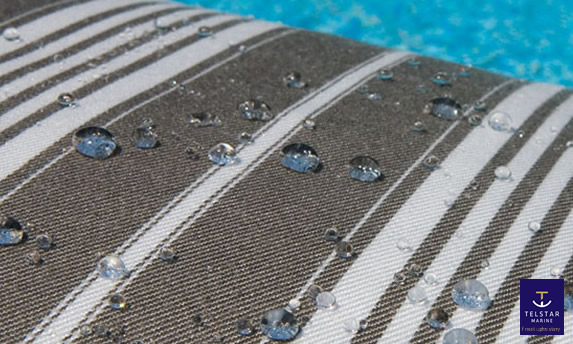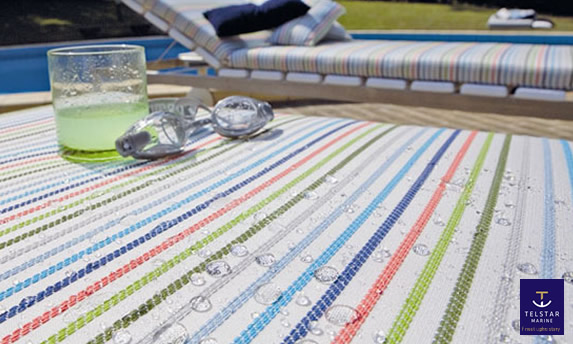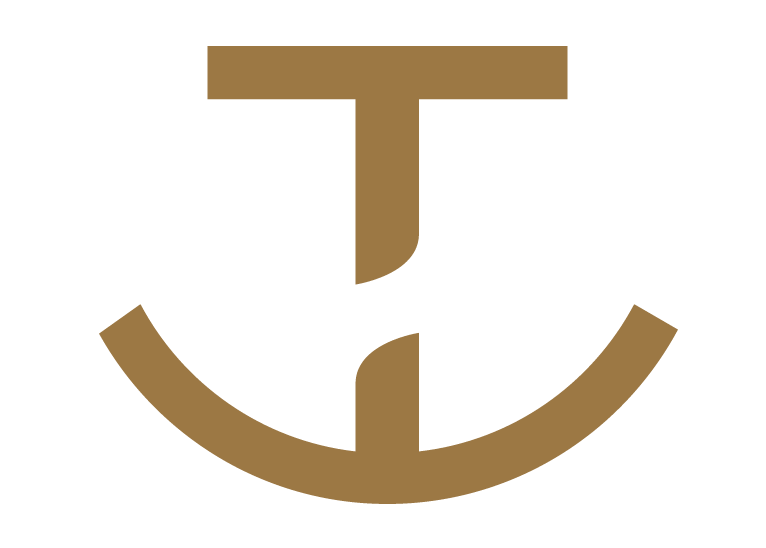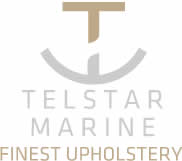Fabrics
outdoor
Most exterior fabrics used on board are made out of a solution dyed acrylic fiber. Brands you need to think of that are using this specific fiber are Sunbrella Outdoor fabrics – Perennials Outdoor fabrics– Maria Flora Outdoor fabrics.
Outdoor fabrics made out of a solution dyed acrylic are sunlight, (sea salt) water and chlorine resistant and are mildew free. Before using below maintenance and cleaning advise please make sure that your exterior fabric is made out of a solution dyed acrylic. Always pretest fabric in an out-of-the way area to guard against color transfer or color change. When your exterior fabric is made out of a solution dyed acrylic you can follow the below directions;
Care/maintenance:
One of the best ways to keep Solution Dyed Acrylic Outdoor fabrics looking good and to delay deep or vigorous cleaning is to properly maintain the fabrics. This can be accomplished by simply brushing off dirt before it becomes embedded in the fabrics, wiping up spills as soon as they occur or spot cleaning soon after stains occur.
When cleaning a cushion constructed of exterior-use foam, we recommend flushing it with water and allowing it to air dry without removing the cover. Repeated removal of the cover
may eventually break down the seams and distort the fabric.
When cleaning a cushion constructed of interior-grade foam, professional cleaning is recommended. Please note that interior-grade foam is never recommended for exterior installation.

General or light cleaning instructions:
1. Brush off any loose dirt.
2. Prepare a cleaning solution of mild soap and lukewarm water.
3. Use a sponge or a soft bristle brush to clean. Avoid excessive brushing that may abrade the fibers.
4. Allow cleaning solution to soak into fabric.
5. Rinse thoroughly with clean water to remove all soap.
6. Allow fabric to air dry.
Spot cleaning:
1. Apply a light mist of mild detergent and water using a spray bottle.
2. Work the solution into the stain by lightly scrubbing the area with a sponge or very soft bristle brush. Avoid excessive brushing.
3. Rinse thoroughly to remove all detergent residue.
4. Blot excess moisture with a clean, soft towel or sponge.
5. Blot excess water.
6. Air dry, Repeat steps 3 and 4 until all soap residue is removed.
For stubborn stains, use a fabric spot remover. Follow the directions on the container. When spot cleaning with a fabric spot remover, always test a small, inconspicuous part of the furniture in case of discoloration or shrinkage.
For removable fabric like cushion covers.
Hand washing :
1. Remove the fabric from the inlay.
2. Soak the fabric in a solution of mild soap and lukewarm water.
3. Use a sponge or a soft bristle brush as necessary.
4. Rinse thoroughly to remove all detergent residue.
5. Air dry.
Machine washing;
1. Remove the fabric from the inlay.
2. Machine wash in cold water.
3. Depending on wash load size, use normal amounts of mild laundry detergent and add 1 cup of bleach.
4. Allow fabric to air dry.
Chlorine:
Chlorine bleach will not affect the coloration of the solution dyed acrylic fiber and is therefore acceptable for stubborn stain removal. Chlorine bleach, strong chemicals or harsh detergents will eventually affect the strength of any fiber or cloth, so we suggest to use always a diluted solution. Thorough rinsing is essential. Please note that chlorine bleach is never recommended as a stain remover for printed fabrics or natural fibers (i.e. hemp), as it will affect the coloration of the print or natural fiber. When you are not sure if your exterior fabric is made out of a Solution Dyed Acrylic DO NOT use Chlorine!
Professional cleaning:
Professional cleaning is always recommended for tough stains. Always ask though if the professional cleaner is used to work with Solution Dyed Acrylic fabrics.
DO NOT Dry clean Solution Dyed Acrylic fabrics.
DO NOT steam or Steam Iron Solution Dyed Acrylic fabrics. If the fabric has some wrinkling, use an iron, but only on the synthetic setting. As some irons exceed the recommended temperature on the synthetic setting, test a small inconspicuous area before ironing entire piece.

Solution dyed Velvet handling and care ;
100% solution dyed acrylic velvets offer a high-performance style and luxury, enhancing living spaces
both indoors and out. With a few basic tips for proper handling and care, these luxurious fabrics will remain beautiful for years to come.
In order to prevent damage to the pile, velvet should never be stored vertically, as the weight of the fabric may sag and unduly press on the lower end of the bolt, potentially resulting in wrinkling. Always store bolts horizontally and suspended if possible.
To remove wrinkling or any change in the pile direction, apply steam gently (no closer than 1/2″ from the surface) while brushing with a soft bristle brush. Final brushing should always be in the direction of the nap. An iron or steamer should never be placed directly on the pile or the backing, as it will damage the fabric.
For everyday maintenance and to best preserve the velvet, we recommend the following:
1. Brush or vacuum any loose dirt from the surface of the fabric, following the direction of the nap.
2. To avoid staining, spills should be removed immediately.
3. Blot any excess liquid from the surface.
4. Using a clean, damp cloth or sponge gently dab spot to remove remaining stain.
5. Rinse with clean water and let air dry.
6. As a final step, comb the pile with a soft, bristle brush in the direction of the nap.




